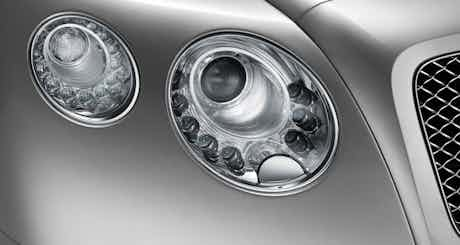How do LED headlights work?
January 14, 2015 by carwow staff

For a long time, the intense competition of motorsport has been known to introduce advanced technology that eventually filters down onto everyday road cars. The likes of disc brakes and windscreen wipers not only could help racers save seconds on the track, but improve the safety and performance of vehicles on the road, too.
One of the latest examples of race-proven gadgetry to make it to the showrooms are LED headlights. Whilst LED sidelights and tail lights have been around for a while, the first full-LED headlights were used by Audi on their highly successful endurance racers. They then transferred the technology onto the R8 supercar in 2010.

How do they work?
In a traditional halogen bulb, the thin filament of wire emits a bright light when a current is passed through it, which over time can degrade and eventually fail. An LED on the other hand, makes use of a semiconductor – a material that releases photons of light when charge is applied. The main benefit of this is there is no filament to burn out, so they shouldn’t ever need to be replaced.
Just like Xenon headlights then?
Not exactly. The main difference between LEDs and HID headlights is that the former are far more efficient. In other words, in order to produce an equal quantity of light, far less energy is required. So much less, in fact, that LEDs tend to be brighter than Xenons, while still drawing less power from the battery and the engine. This means that – although marginal – any car running with LED headlights switched on will be more fuel efficient than an equivalent halogen or Xenon-equipped car.
Any other benefits?
Several. The light from an LED can not only shine further, but more accurately, too. Companies like Audi have developed computer systems which can sense oncoming traffic and deflect the light beams accordingly in order to reduce glare for other drivers.
The light itself is also much closer in tone to natural light, which makes driving at night less of a strain on the eyes.

Who uses them?
Due to their high cost, they rarely find themselves equipped to anything other than brands at the premium end of the scale – the likes of Audi, BMW, Infiniti, Land Rover, Lexus and Mercedes all make used of them.
However, some mainstream brands have started to offer them as an optional extra on their higher spec models, most notably Ford with the new Mondeo, Seat on the fanciest Leons and Citroen with top-spec DS3s. Once the cost of the technology reduces further, more firms are sure to follow suit and add them to their range.

Anything else on the Horizon?
Yes. Not one to rest on their laurels, Audi have used their Le Mans 24 Hour-winning racing cars to introduce the next big thing. Laser lights are even brighter than LEDs, and can be aimed even more efficiently. Currently very few road cars use them, the special edition Audi R8 LMX was equipped with them as standard, while the BMW i8 offers them as an option.















